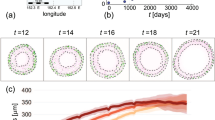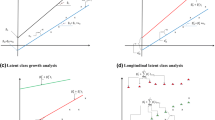Abstract
The use of martingale residuals have been proposed for modelchecking and also to get a non-parametric estimate of the effectof an explanatory variable. We apply this approach to an epidemiologicalproblem which presents two characteristics: the data are lefttruncated due to delayed entry in the cohort; the data are groupedinto geographical units (parishes). This grouping suggests anatural way of smoothing the graph of residuals which is to computethe sum of the residuals for each parish. It is also naturalto present a graph with standardized residuals. We derive thevariances of the estimated residuals for left truncated datawhich allows computing the standardized residuals. This methodis applied to the study of dementia in a cohort of old people,and to the possible effect of the concentration of aluminum andsilica in drinking water on the risk of developing dementia.
Similar content being viewed by others
References
A. C. Alfrey, G. R. Legendre, W. D. Kaehny, “The dialysis encephalopathy syndrome: possible aluminum intoxication,” N Engl J Med vol. 294 pp. 184-188, 1976.
P. K. Andersen, Ø. Borgan, R. D. Gill and N. Keiding, Statistical Models Based on Counting Processes, Springer-Verlag: New York, 1993.
W. E. Barlow, R. L. Prentice, “Residuals for relative risk regression,” Biometrika vol. 75 pp. 65-74, 1988.
J. D. Birchall, J. S. Chappell, “Aluminum, water chemistry and Alzheimer's disease,” Lancet 1989; i pp. 953, 1989.
D. Commenges, L. Letenneur, P. Joly, A. Alioum and J. F. Dartigues, “Modelling age-specific risk: application to dementia,” Stat Med vol. 17 pp. 1973-1988, 1998.
D. Commenges and H. Jacqmin-Gadda, “Generalized score test of homogeneity based on correlated random effects model,” J Roy Stat Soc B vol. 59 pp. 157-171, 1997.
T. R. Fleming and D. P. Harrington, Counting Processes and Survival Analysis, Wiley: New-York, 1991.
H. Jacqmin-Gadda, D. Commenges, L. Letenneur, J. F. Dartigues, “Silica and aluminum in drinking water and cognitive impairment in the elderly,” Epidemiology vol. 7 pp. 281-285, 1996.
C. N. Martyn, D. J. Barker, C. Osmond, E. C. Harris, J. A. Edwardson, R. F. Lacey, “Geographical relation between Alzheimer's disease and aluminum in drinking water,” Lancet vol. 1; i pp. 59-62, 1989.
C. N. Martyn, D. N. Coggon, H. Inskip, R. F. Lacey, W. F. Young, “Aluminum concentrations in drinking water and risk of Alzheimer's disease,” Epidemiology vol. 8 pp. 281-6, 1997.
Author information
Authors and Affiliations
Rights and permissions
About this article
Cite this article
Commenges, D., Rondeau, V. Standardized Martingale Residuals Applied to Grouped Left Truncated Observations of Dementia Cases. Lifetime Data Anal 6, 229–235 (2000). https://doi.org/10.1023/A:1009637608473
Issue Date:
DOI: https://doi.org/10.1023/A:1009637608473




